“How much will I save on my power bill if I install solar?”
For those considering installing solar for their home or business, it’s a great question. After all, a major reduction in utility costs is one of solar’s greatest selling points for the average consumer.
Unfortunately, knowing exactly how much your electricity bill will be reduced isn’t a simple or across-board answer - there is a multitude of factors that need to be considered before you can estimate how much solar will shave from your power bill.
Continue reading to learn what these factors are and how these factors will influence your solar savings.
We’ll pretend to have three run-of-the-mill customers for who we’re trying to find what their yearly solar savings are predicted to be (by working through the factors below). This should help provide a fairly generic idea of how much a 2-person household, a 4-person household, and a medium-sized business would save on electricity bills if they installed solar.
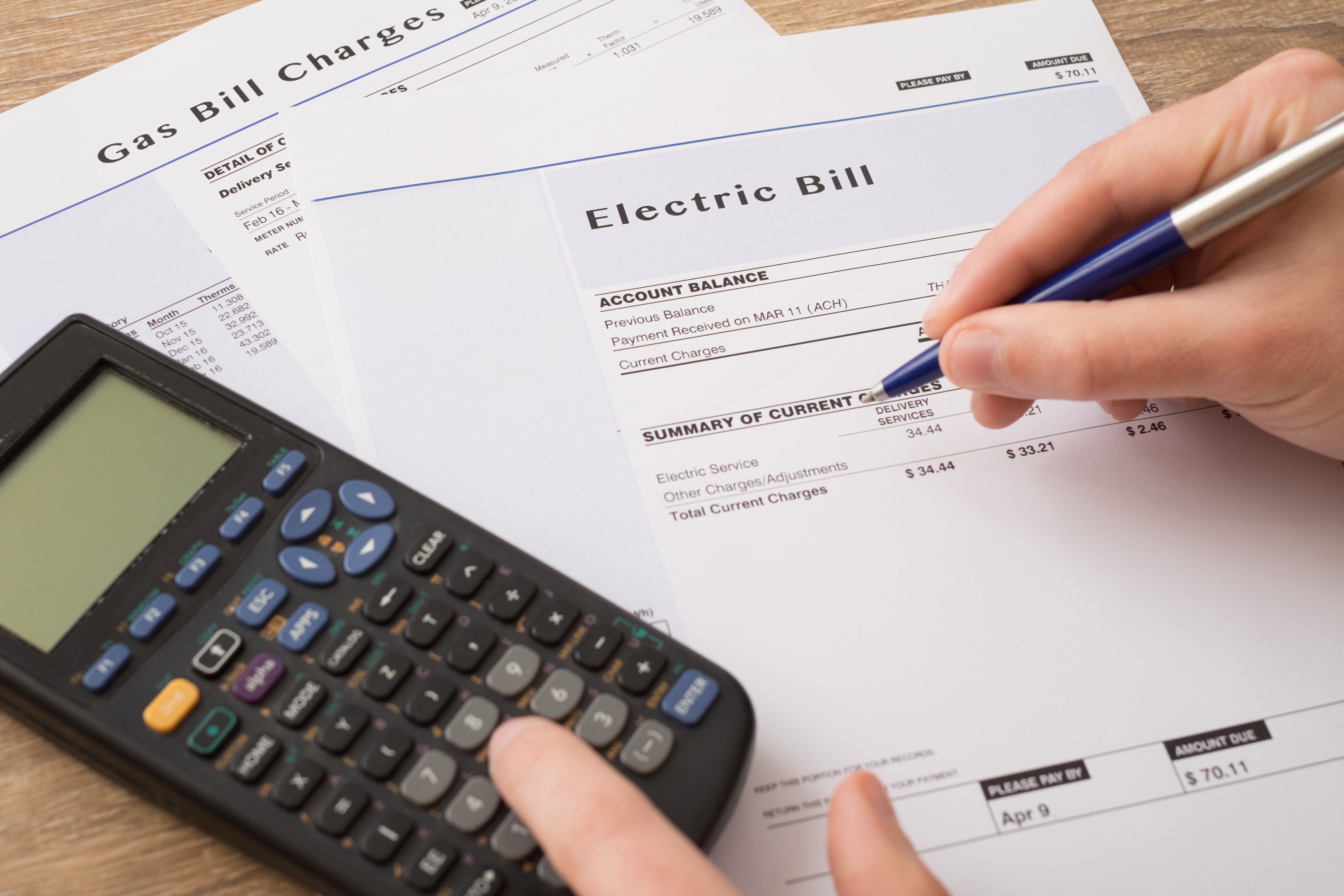
Factors That Influence Your Solar Savings
Where you live
Your average energy consumption
Solar system capacity
Self-consumption rate
Your feed-in tariff rate
Quality of components
Whether you have solar storage capacity
Where you live
Your average energy consumption
Solar system capacity
Self-consumption rate
Your feed-in tariff rate
Quality of components
Whether you have solar storage capacity
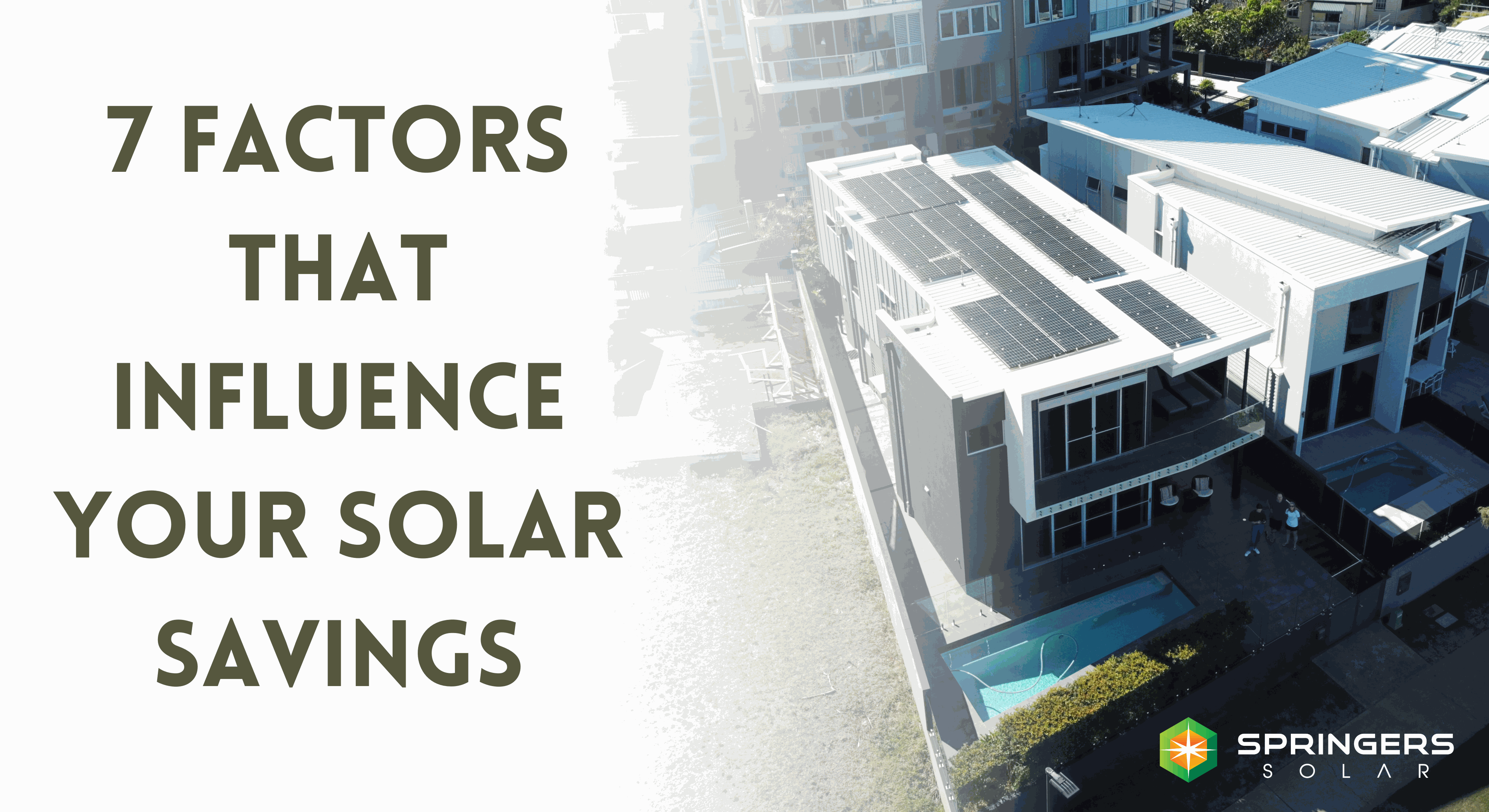.png)
Where You Live
It’s no secret that Australians benefit from a high concentration of solar radiation, so we are lucky to be naturally positioned for optimal solar panel performance. However, solar savings can still vary depending on which state or territory in which you live.
Queensland, Western Australia, and the Northern Territory enjoy the highest rates of solar production across the country. This means that a solar system installed in Brisbane will have a greater yield of solar electricity than an equivalent solar system installed in Melbourne. Therefore, the Brisbane household is naturally going to see higher solar savings on their electricity bill.
Take your location into consideration when thinking about solar energy system size and the savings you’ll see on your bill - if you’re based in a temperate or cold climate, you may need to install a larger capacity solar system to achieve the same output as a household in a warmer location.
For the sake of simplicity, all examples will be based in Brisbane, Queensland.
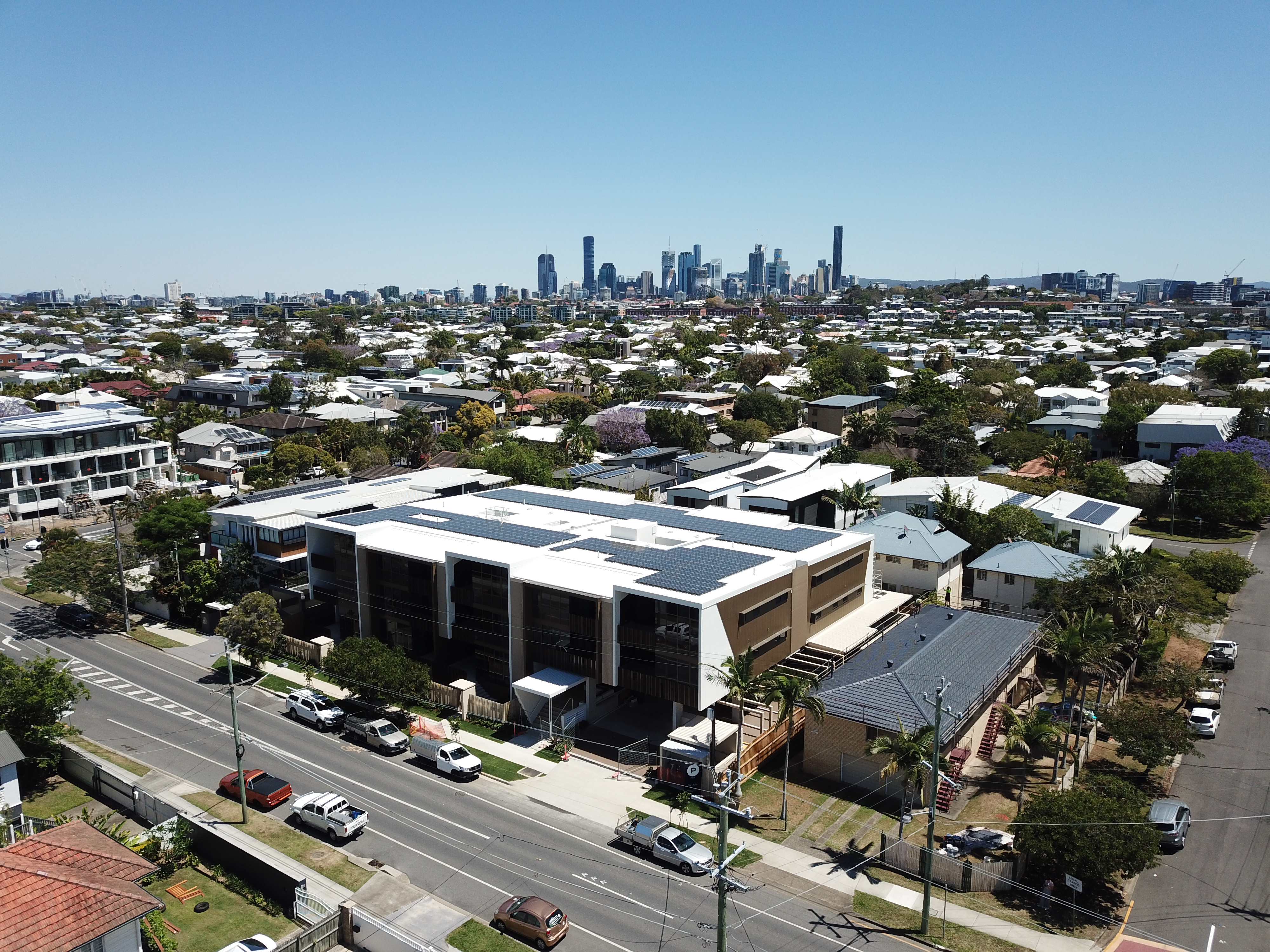
Your Average Energy Consumption
It is important to select a solar system that suits your energy consumption - an undersized solar system is a danger to your return on investment (ROI), and you won’t reap the maximum reward that solar can bring to your power bill.
You can determine your property’s average energy consumption by having a look at your recent electricity bills. The amount of electricity you use will be shown in kWh and will give you a decent indication of how much power your home requires on a daily, monthly, or quarterly basis.
A 2-person Brisbane household will consume 5,128kWh of electricity per annum. This will cost around $1,330 in electricity bills every year.
A 4-person Brisbane household will consume 7,684kWh of electricity per annum. This household’s electricity bill will come in around $1,990 per year.
A medium-sized Queensland commercial office will consume 46,054kWh of electricity per annum. This will cost approximately $12,000 in electricity bills every year.
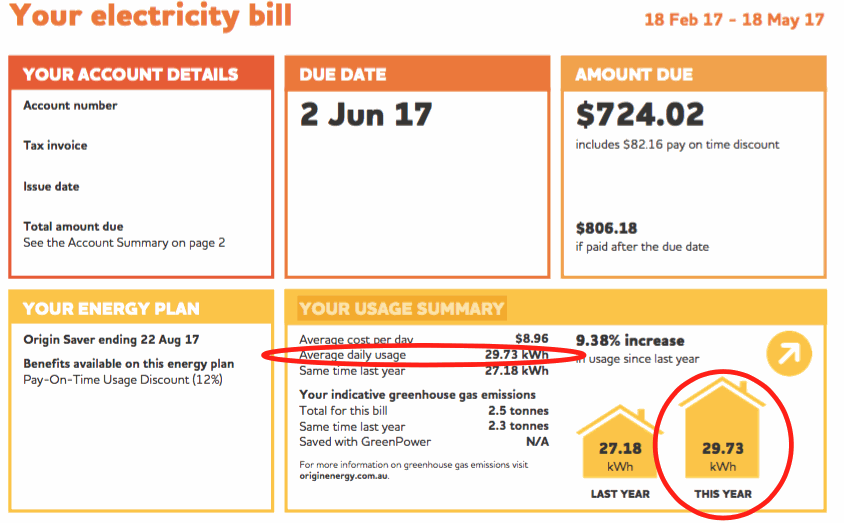
Solar System Capacity
The larger your solar kW capacity, the more solar energy your system will produce. So a 10kW system is twice as powerful as a 5kW solar system, for example.
This directly correlates with how much money will be saved on your electricity bill, as the larger your system is, the more money you will save as your home is powered on a greater portion of solar energy.
It is generally recommended that if you can, oversizing your solar system by 10-20% is ideal. Not only does a larger solar system further reduce your reliance on the grid, but it also gives you the flexibility to accommodate future power consumption or energy users that may be added to your property in the future.
If you’re considering installing solar batteries, EV chargers, pools, or other large energy consumers later down the track, installing a larger system now will save you from having to expand your system in the future (which is costly).
Installing a larger system also means you can claim more STCs (Australia’s solar rebate, or “discount”), which provides you greater value now than it would in the future when STCs are inevitably worth less. Learn more about STCs here.
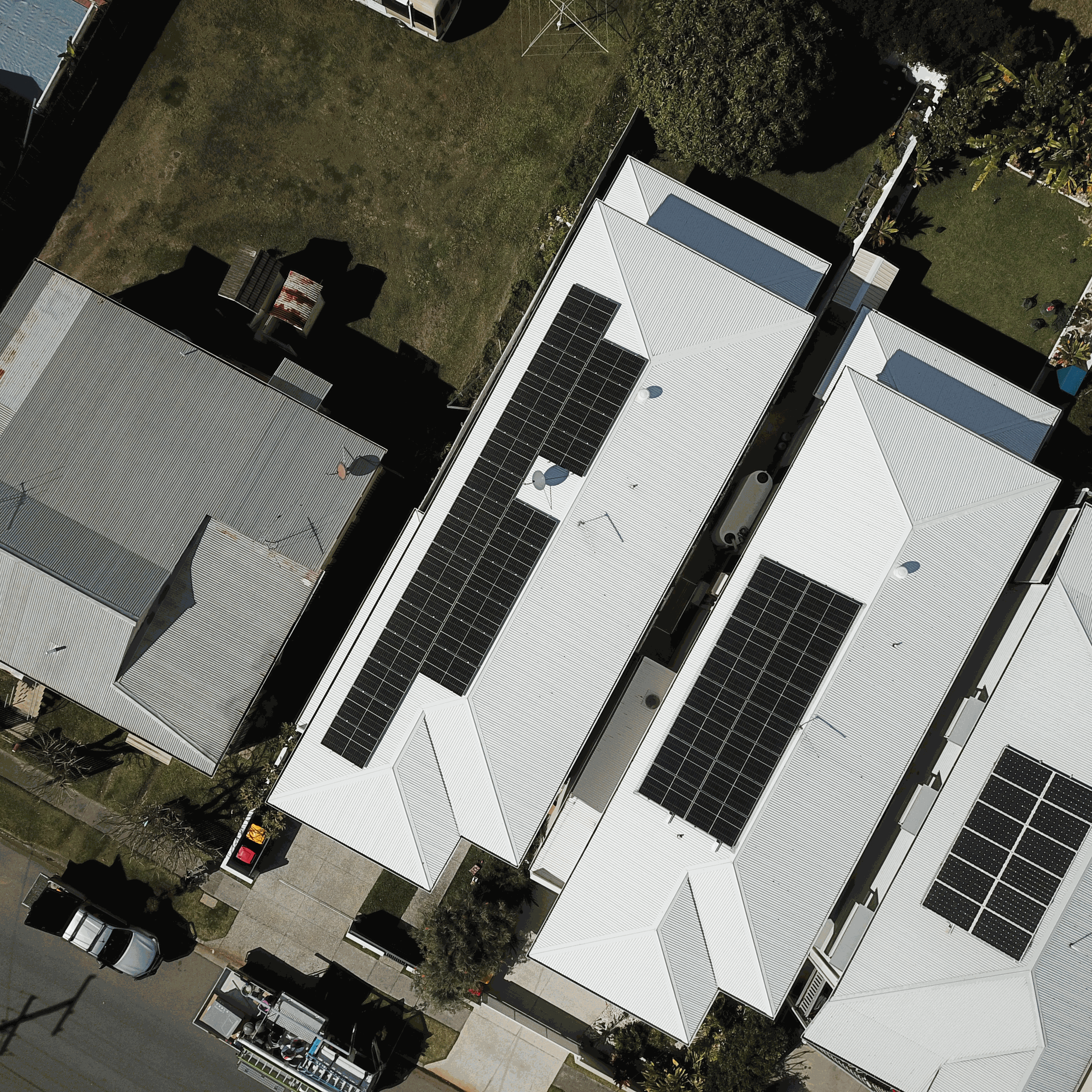
It is approximated that for each kW of solar panels, you can expect to see about 4kWh per day of solar energy generation. This means that if you have a 10kW solar system, your panels will produce around 40kWh of electricity every day.
The 2-person household has installed a 3.5kW solar system to produce 14kWh of electricity every day, which will cover their annual energy consumption of 5,128kWh. Let’s say this system cost $4,500.
The 4-person household has installed a 5.5kW solar system to produce 21kWh of electricity every day, which will cover their annual energy consumption of 7,684kWh. Let’s assume this system cost $7,500.
The medium-sized commercial office has installed a 31.5kW solar system to produce 126kWh of electricity every day, which will cover their annual energy consumption of 46,054kWh. Let’s say this system cost $35,000.
Self-Consumption Rate
Solar panels produce solar energy during the day while the sun is shining and yield gradually decreases in the evening as the sun starts to set. Working in an office during the day and only returning home in the evening may affect the savings you see on your bill.
This is because your home will source electricity from the grid if you are consuming more energy than your solar system is generating. In the evenings when solar generation is decreasing and energy usage typically increases as people return home from work, homeowners may find that they are not achieving their solar saving goals.
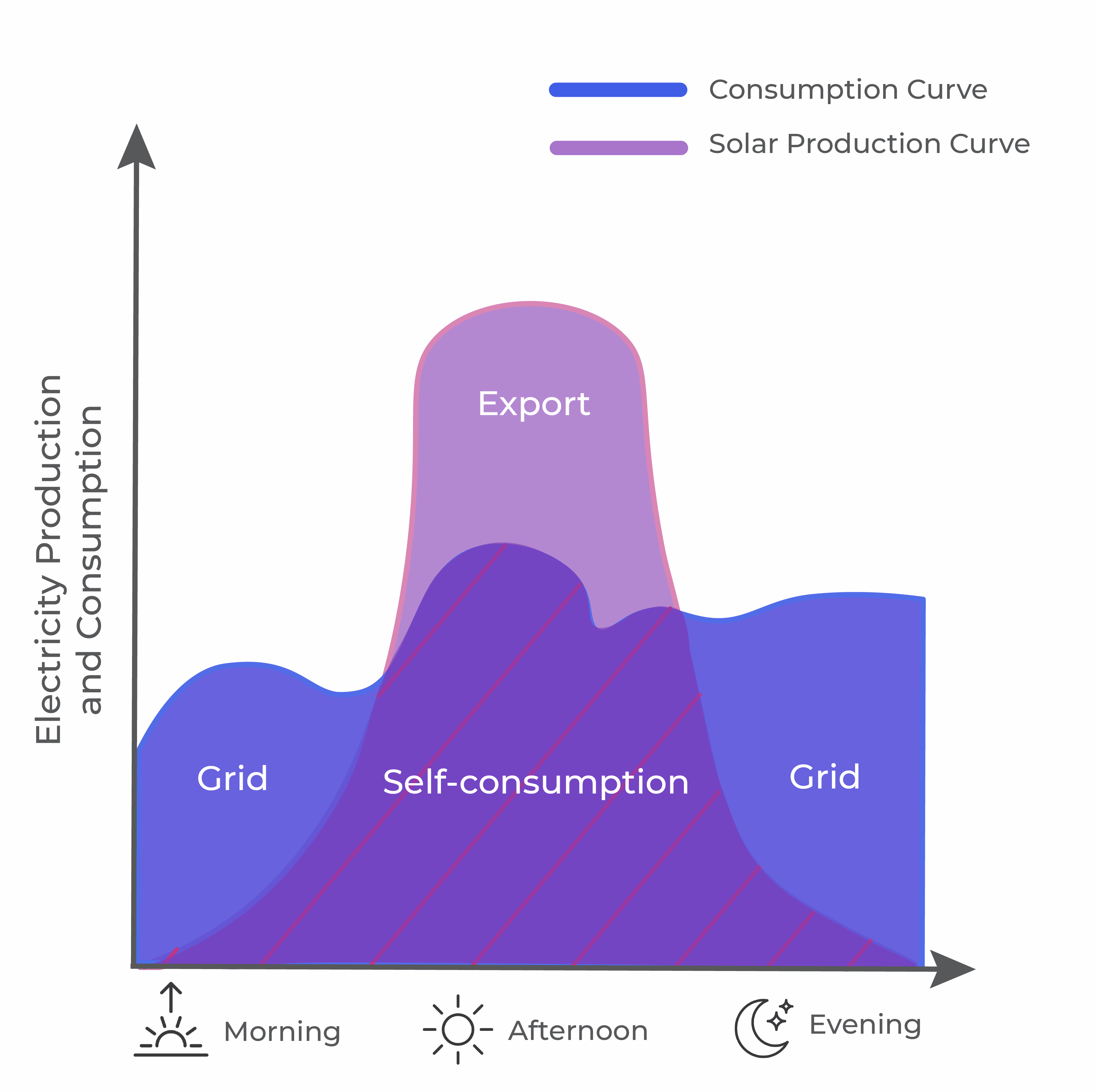
There are a couple of ways to get around this. The first is improving your solar self-consumption, by using high energy-consuming appliances during the day to be offset by solar. This can usually be done with timers or a slight shift to lifestyle routines. Read more on ways to improve your solar self-consumption here.
Or, solar batteries can be installed to catch excess solar energy not used during the day to later be used in the evenings or at night. Read more on the benefits of installing a solar battery here.
The 2-person household produces 5,110kWh of solar energy every year, of which approximately 75% is used to power the home. The remaining 25% was exported to the grid which helps to offset their energy bill with the feed-in tariff credits, which will be explained in the next section. This means from self consumption alone they have been able to reduce their energy costs by $958 (5,110kWh (solar production) x .75 (% of self consumption rate) x $.25 cost of energy we have used in this example). Further bill savings are achieved with feed-in tariff credits, see below.
The 4-person household produces 7,665kWh of solar energy every year, of which 75% is used to power the home. Again, the remaining 25% was exported to the grid which helps to offset their energy bill with the feed-in tariff credits, which will be explained in the next section. This means from self consumption alone they have been able to reduce their energy costs by $1,437 (7,665kWh (solar production) x .75 (% of self consumption rate) x $.25 cost of energy we have used in this example). Further bill savings are achieved with feed-in tariff credits, see below.
The medium-sized commercial office produces 45,990kWh of solar energy every year, of which 85% is used to power the office. The remaining 15% was exported to the grid which helps to offset their energy bill with the feed-in tariff credits, which will be explained in the next section. This means from self consumption alone they have been able to reduce their energy costs by $9,773 (45,990kWh (solar production) x .85 (% of self consumption rate) x $.25 cost of energy we have used in this example). Further bill savings are achieved with feed-in tariff credits, see below.
*The above are examples only and may not be applicable to everyone. Metering, network connection charges, and energy prices vary greatly between energy retailers which may impact your solar savings. To personalise for you, our friendly solar energy consultants can review your energy bill to provide you with a proposal for solar along with your savings estimate.
Your Feed-In Tariff
You will have an agreement with your electricity supplier regarding a feed-in tariff (FiT), and this FiT is credit customers receive from their power provider when unused energy from their solar system is exported to the grid.
As of 2022, anywhere from 6 cents per kWh to 9 cents per kWh is the average tariff offered by electricity retailers. The credit is applied to your electricity bill and can further reduce the cost of your electricity import from the grid. Read more about feed-in tariffs here.
Depending on how much solar you export back to the grid and your FiT rate can help improve the savings you see from solar.
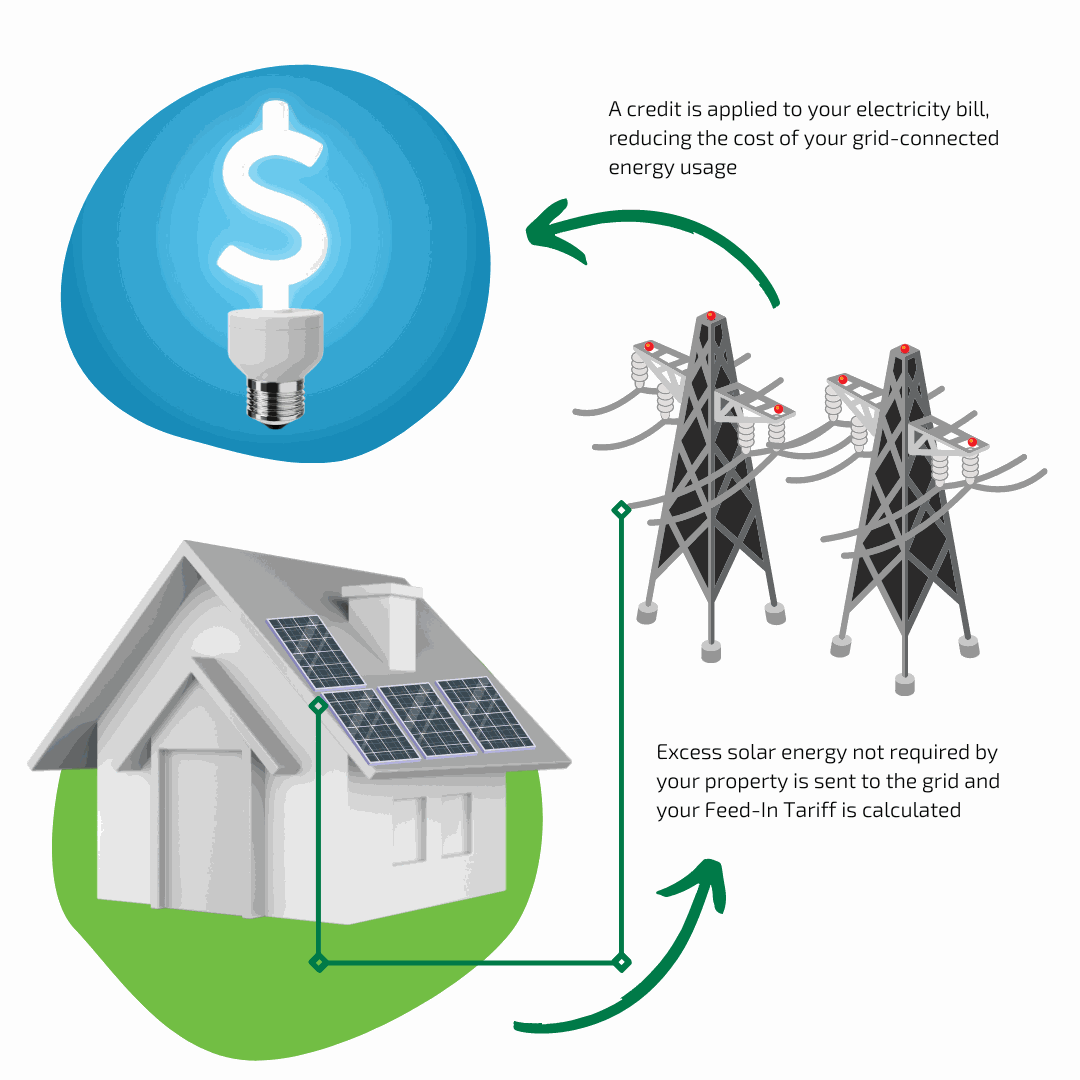
The 2-person household is on a FiT rate of 8 cents per kWh. As they export 25% of their solar energy yield to the grid, this means they receive a credit of approximately $102 p.a. for exporting 1,278kWh. If we apply this credit in conjunction with their solar self-consumption savings, their regular electricity bill of $1,330 p.a. will reduce to $270 p.a.
The 4-person household is on a FiT rate of 5 cents per kWh. As they export 25% of their solar energy yield to the grid, this means they receive a credit of approximately $96 p.a. for exporting 1,917kWh. If we apply this credit in conjunction with their solar self-consumption savings, their regular electricity bill of $1,990 p.a. will reduce to $457 p.a.
The medium-sized commercial office is on a FiT rate of 10 cents per kWh. As they export 15% of their solar energy yield to the grid, this means they receive a credit of approximately $690 p.a. for exporting 6,899kWh. If we apply this credit in conjunction with their solar self-consumption savings, their regular electricity bill of $12,000 p.a. will reduce to $1,5,37 p.a.
*The above are examples only and may not be applicable to everyone. Metering, network connection charges, and energy prices vary greatly between energy retailers which may impact your solar savings. To personalise for you, our friendly solar energy consultants can review your energy bill to provide you with a proposal for solar along with your savings estimate.
Quality of Components
If there is one rule of thumb with solar, it is to never trust a cheap system. Cheap systems are made of cheap components, which will always cost you more down the track to fix or replace entirely.
Ill-quality components are highly unreliable in terms of both effectiveness and longevity, and notoriously make the poor man pay twice due to inevitable issues in the future. The key to ensuring quality components is to source a reliable installer with great customer testimonials and proven performance.
"If there is one rule of thumb with solar, it is to never trust a cheap system."
A good solar installer will select quality components with industry-leading warranties, ensuring that your system operates at maximum efficiency for the duration of its life. At the end of the day, if your system isn’t protected by warranty then your investment is at risk of burdening more than benefitting.
Aim for solar panels with a warranty of 20+ years, inverters with warranties of 15+ years, and if selecting a battery, make sure it’s covered for at least 10 years.
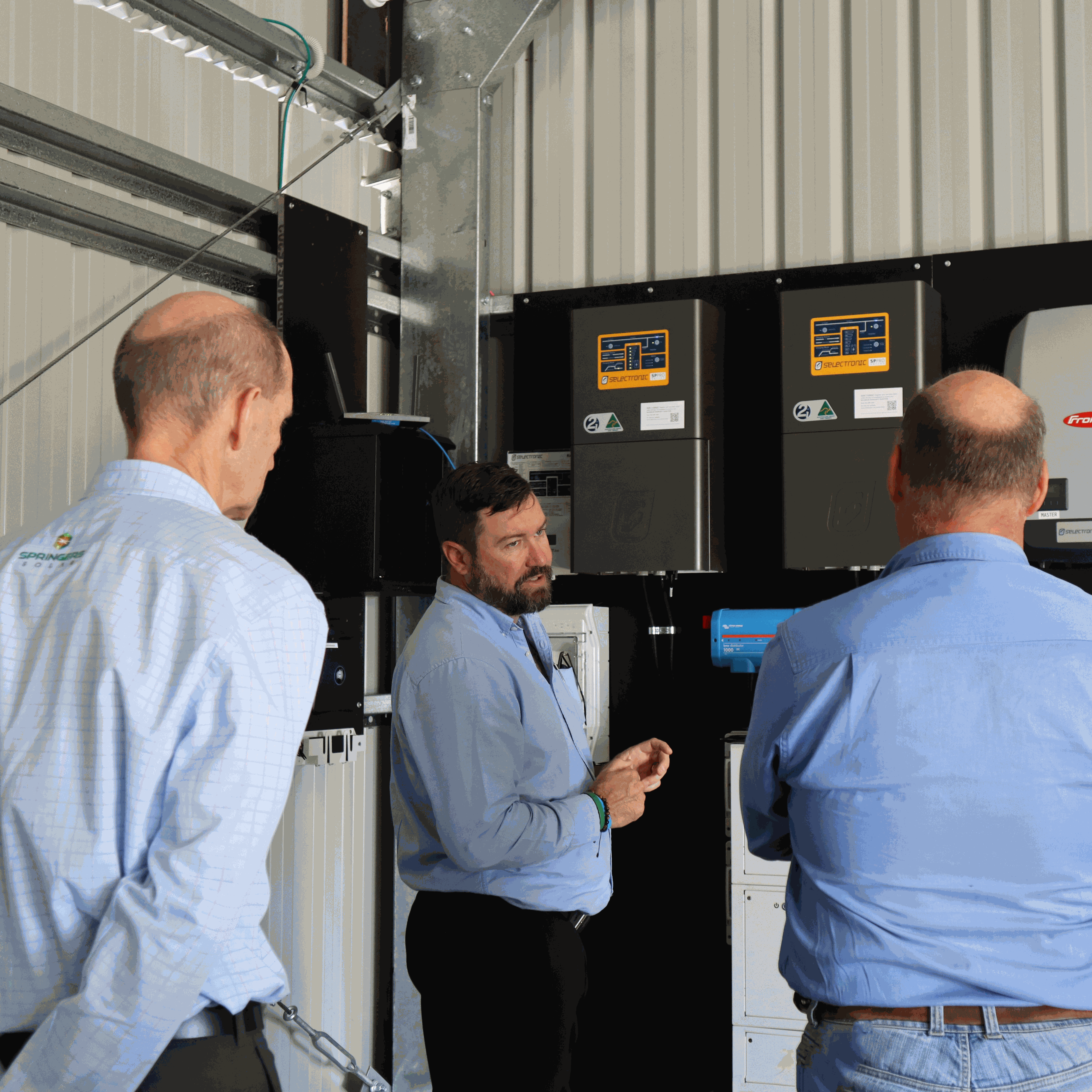
Basically, the longer your solar system lasts, the more savings you will accrue - it’s a no-brainer.
The 2-person household’s solar system is assumed to produce solar for the next 25 years. The 3.5kW system will pay itself off in around 4.2 years, meaning that for the remaining 20.8 years of the system’s life, the savings go directly back to the homeowner.
The 4-person household’s solar system is assumed to produce solar for the next 25 years. The 5.5kW system will pay itself off in around 4.8 years, meaning that for the remaining 20.2 years of the system’s life, the savings go directly back to the homeowner.
The medium-sized commercial office’s solar system is assumed to produce solar for the next 25 years. The 31.5kW system will pay itself off in around 3.3 years, meaning that for the remaining 21.7 years of the system’s life, the savings go directly back to the business.
Solar Storage Capacity
Improved technology in recent years has seen a surge in solar battery installations, particularly as feed-in tariff rates have been on the decline. Solar batteries allow property owners to collect any unused solar energy during the day to store in a battery for later use, rather than exporting unused solar to the grid for the FiT.
Improved technology in recent years has seen a surge in solar battery installations, particularly as feed-in tariff rates have been on the decline. Solar batteries allow property owners to collect any unused solar energy during the day to store in a battery for later use, rather than exporting unused solar to the grid for the FiT.
.jpg)
It is still an expensive option for most, but it gives property owners the ability to completely eliminate their electricity bill altogether.
To keep things simple, we aren’t going to give our example customers a solar battery. The savings from a battery are dependent on a number of other factors not mentioned in this list. So, if you’d like to learn more about how a battery could benefit your home or business, we recommend you contact us.
The Results - How Much Can You Save on Power Bills with Solar in Australia?
We’re not kidding when we say that solar is one of the easiest and most effective ways to significantly reduce your utility bills for the long term. With short payback periods in comparison to the lifespan of a good quality solar system, the savings that go directly into the pocket are substantial.
Having a look at the three example customers we’ve been analysing throughout this article, here are the final results for their expected savings:
The 2-person household will save approximately $1,060 per year with solar (including the FiT rate). Once the payback period has been completed, the system will save the couple approximately $22,028 in electricity costs over the next 20.8 years.
The 4-person household will save approximately $1,533 per year with solar (including the FiT rate). Once the payback period has been completed, the system will save the family approximately $30,966 in electricity costs over the next 20.2 years.
The medium-sized commercial office will save approximately $10,463 per year with solar (including the FiT rate). Once the payback period has been completed, the system will save the business approximately $227,047 in electricity costs over the next 21.7 years.
*The above are examples only and may not apply to everyone. Metering, network connection charges, and energy prices vary greatly between energy retailers which may impact your solar savings. To personalise for you, our friendly solar energy consultants can review your energy bill to provide you with a proposal for solar along with your savings estimate.
*The above examples also assume component efficiency doesn't decline for the sake of simplicity. It is important to note that efficiency does decrease with time, which will also influence your solar bill savings over the long-term.
Without a doubt, solar is a wise and achievable investment for the average Australian home or business.
Solar Will Only Save You Money When Installed By a Reputable and Long-Standing Installer
It is critical to choose your solar installer carefully if you decide to proceed with solar. Unfortunately, the solar industry is fraught with companies whose aim is to make a quick buck with a cheap install with cheap components. If you think the price is too good to be true, then it probably is.

Always choose a solar installer that has been trading for at least 10-15 years. A long-standing installer will be able to honour their warranties and service guarantees. A ‘solar orphan’ is someone whose installer has fallen out of business and thus has no points of contact for warranty claims or system support (unfortunately, this happens a lot more than you may think!).
Your solar installer should also complete a site inspection and analysis of your personal energy needs, to design a system that is most suited to your energy goals. On-site inspections are preferable, as this will help to avoid any hidden fees or additional costs that may be incurred come the day of installation (as pricing is always subject to inspection).
In summary, the most important things to look for when selecting an installer are evidence of customer testimonials focused on reliability and honesty, a high standard of workmanship, warranty periods, and quality components.
In summary, the most important things to look for when selecting an installer are evidence of customer testimonials focused on reliability and honesty, a high standard of workmanship, warranty periods, and quality components.
Springers Solar | Queensland's Most Experienced Solar Installer
Springers Solar provides quality components with proven performance, backed by industry-leading warranties, and dedicated after-sales support. Thousands of satisfied customers over more than 20 years of operation make Springers Solar one of the most established and experienced solar companies in Australia.
Springers Solar has received multiple awards for design and installation and is a certified/preferred installer for a large range of solar panel, inverter, and solar battery manufacturers, including Tesla, REC, and SolarEdge.
Our dedicated in-house team of electrical engineers, project managers, solar PV designers, solar installers and electricians work closely with you before, during, and long after your project is completed. Springers Solar offers an industry-leading 10-year workmanship warranty which is a testament to our qualified staff and offers you outstanding value and peace of mind.
Solar Bill Savings - How Much Will You Save On Your Power Bill With Solar?